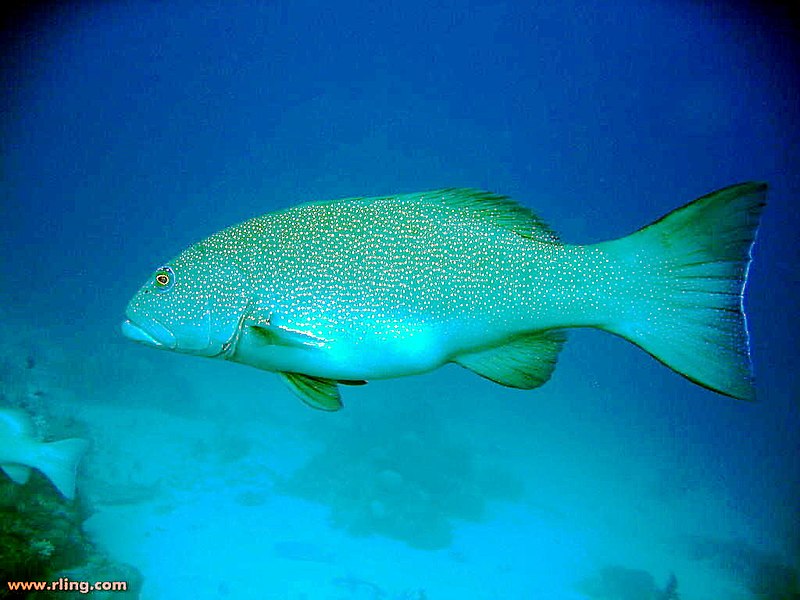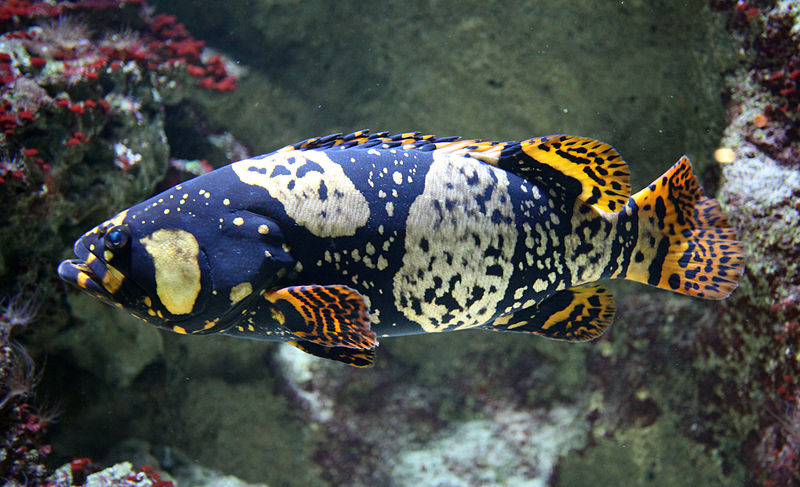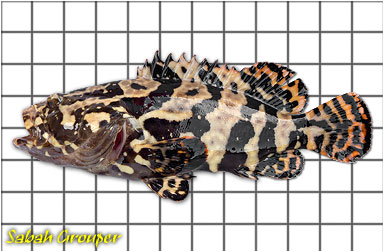“Again, the kingdom of heaven is like a net that was thrown into the sea and gathered fish of every kind.”
Matthew 13:47 (ESV)
“There are five ways to make money, and aquaculture ranks first.”
Fan Li famous reply to King Qi Wei on the secret of his wealth and success, 2,500 years ago, China.
Exploring the Essence of Your Work and Corporate Mission
What is the driving force behind your professional endeavours?
• You will possess the capacity to curtail illicit fishing practices such as cyanide squirting and fish bombing within the lush tropical coral reefs.
• You have the opportunity to invest in aquaculture farms, a sustainable means of supplying protein-rich food while aiding in the rehabilitation of dwindling wild fish stocks.
What are the foundational principles that steer your organization’s values?
• The goal is to identify and seize lucrative opportunities that yield returns within a single year.
• Aspire to attain the pinnacle of success in the grouper aquaculture sector throughout the Asia Pacific, establishing your company as an industry leader.
Aligning your individual efforts with your corporate mission can propel the tropical aquaculture industry to unprecedented heights and wield significant influence in safeguarding coral reef ecosystems.
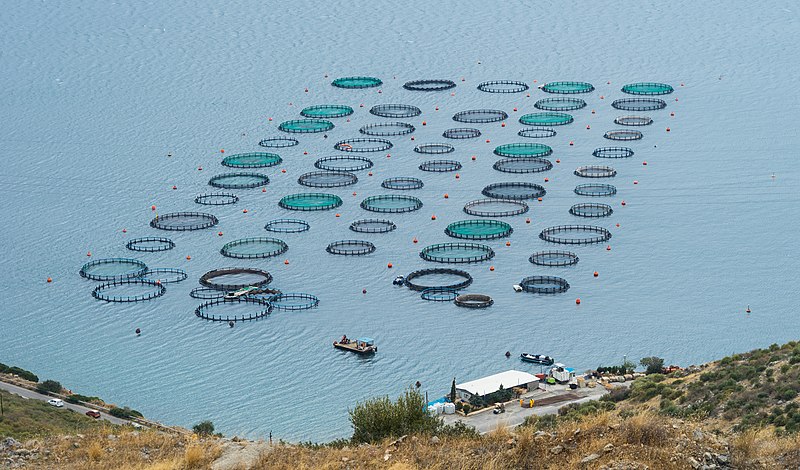
1.0 Executive Summary
Mission
• Goal: To invest in and cultivate open pan sea cage fish farming of grouper, with a total production target of 400,000 metric tons, generating an annual income of US$8 billion.
• Stage 1: Investment in a 2,000-hectare fish farm near the coastal sea in Sabah, with marine fish production aiming to reach 160,000 metric tons per year. Targeting the east coast areas of Semporna, Kunak, Lahad Datu, Sandakan, and Tawau. (Total area, including a 15 km buffer zone, amounts to 12,000 hectares).
• Stage 2: Expansion of an additional 3,000 hectares of the fish farm in Kalimantan, Sarawak, and Brunei, with a production target of 240,000 metric tons per year.
Key Management Team
• Mentors: Visionary pioneers and industry leaders with a vast global network, offering invaluable guidance and inspiration.
• Coaches: Mission-oriented industry experts providing practical solutions to challenges, ensuring the team remains focused on its objectives.
• Partners:
- An aquaculture project leader with a strategic vision and the motivation to revolutionise the world’s protein source.
- A reputable financier with access to aquaculture funding.
- A team of experienced international aquaculture operators.
- Target market groups in North Asia.
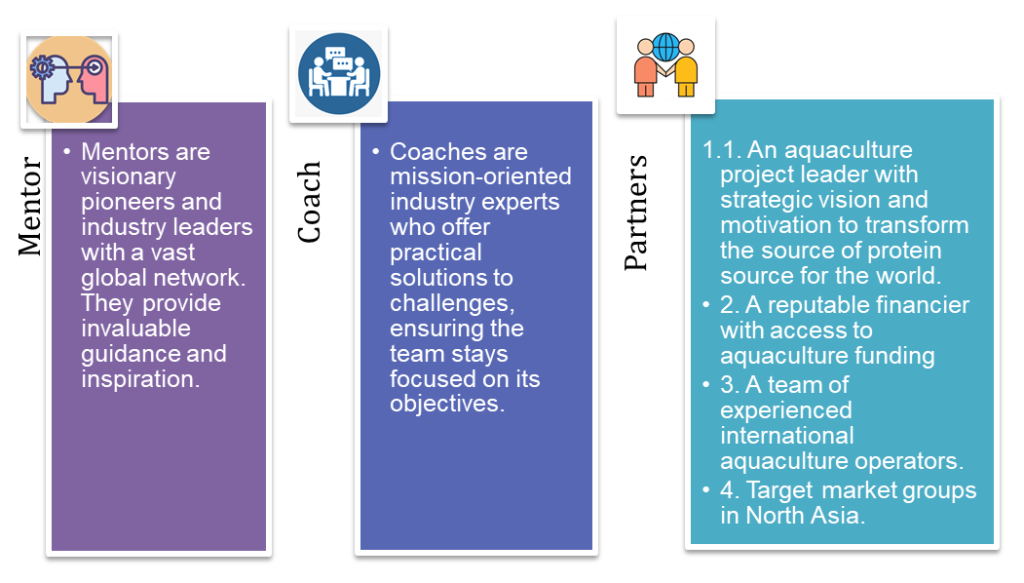
Product Benefits
• Effective: Open-pen sea cage fish farming offers efficient aquaculture management, leading to reduced disease outbreaks, low mortality rates, and stable production.
• Sea: The sea surrounding Borneo provides an ideal environment for the marine aquaculture industry.
• Popular: Grouper species are highly sought after in Asia and the Middle East.
• Efficient: Fish farming is more efficient in protein production compared to other sources. The feed conversion ratio for aquaculture production is 1:1, while chicken production is 2:1, pig production is 3:1, and beef production is 7:1.
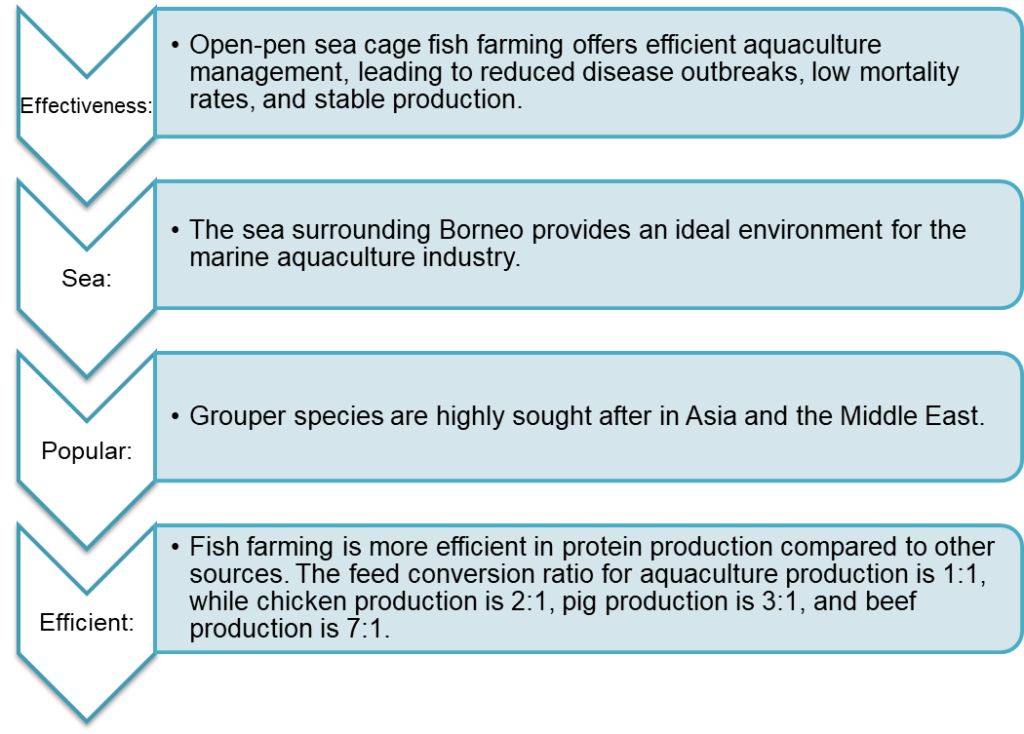
Target Market
- Segment: Grouper species, including Leopard Coral Trout, Sabah Grouper, and Giant Grouper.
- Markets: Singapore, Hong Kong, China, and North Asia.
Financial Projections
- Investment: US$0.63 billion
- Cost: US$2.2 billion/year
- Revenue: US$8.0 billion/year
- Income: US$5.8 billion/year
- Payback: 2–3 years (Allow for price fluctuation)

Unique Business Model
- Identification and capture of both the quantity and quality demand in the end market.
- Collaboration with leading international aquaculture farm operators.
- Establishment of a solid financial foundation.
- Strategic positioning in close proximity to the Asia Pacific markets, facilitating future expansion opportunities.
2.0 Mission
2.1 Problem
- Unsustainability: The global commercial fishing industry grapples with issues like overfishing, bycatch, damage to ocean ecosystems, illegal fishing, and inadequate fisheries management.
- Protein Demand: A rising global population is driving an increased demand for seafood protein, which the commercial fishing industry struggles to meet sustainably.
- Depletion in Indonesia: In Indonesia, 50% of the nation’s wild fish stocks have been overexploited, placing immense pressure on the 267 million people who rely on fish as their primary protein source.
2.2 Solution
- Embracing Aquaculture: Aquaculture emerges as a sustainable solution for providing protein-rich food while contributing to the replenishment of wild fish stocks.
- Enhanced Efficiency: Aquaculture boasts more efficient feed conversion rates compared to poultry, pigs, and beef production.
2.3 Mission
1. Goal
Objective: To invest in and cultivate open pan sea cage fish farming of grouper, with a target production of 400,000 metric tons, generating an annual income of US$8 billion.
Stage 1
Initial Investment: The first stage involves investing in a 2,000-hectare fish farm located near the coastal sea in Sabah. This farm aims to achieve a marine fish production rate of 160,000 metric tons per year. The target areas on the east coast include Semporna, Kunak, Lahad Datu, Sandakan, and Tawau. (The total area, encompassing a 15 km buffer zone, amounts to 12,000 hectares).
Stage 2
Expansion: The second stage entails expanding the operation by an additional 3,000 hectares, extending into Kalimantan, Sarawak, and Brunei. The production target for this phase is 240,000 metric tons per year.
Marine cage aquaculture potential land (ha) in Sabah

3.0 Product
3.1 Product Description
Open-pen sea cage grouper farming represents an exceptional source of protein, offering competitive costs. The operator can harvest the product within a 12-month timeframe.
Production cycle of grouper.
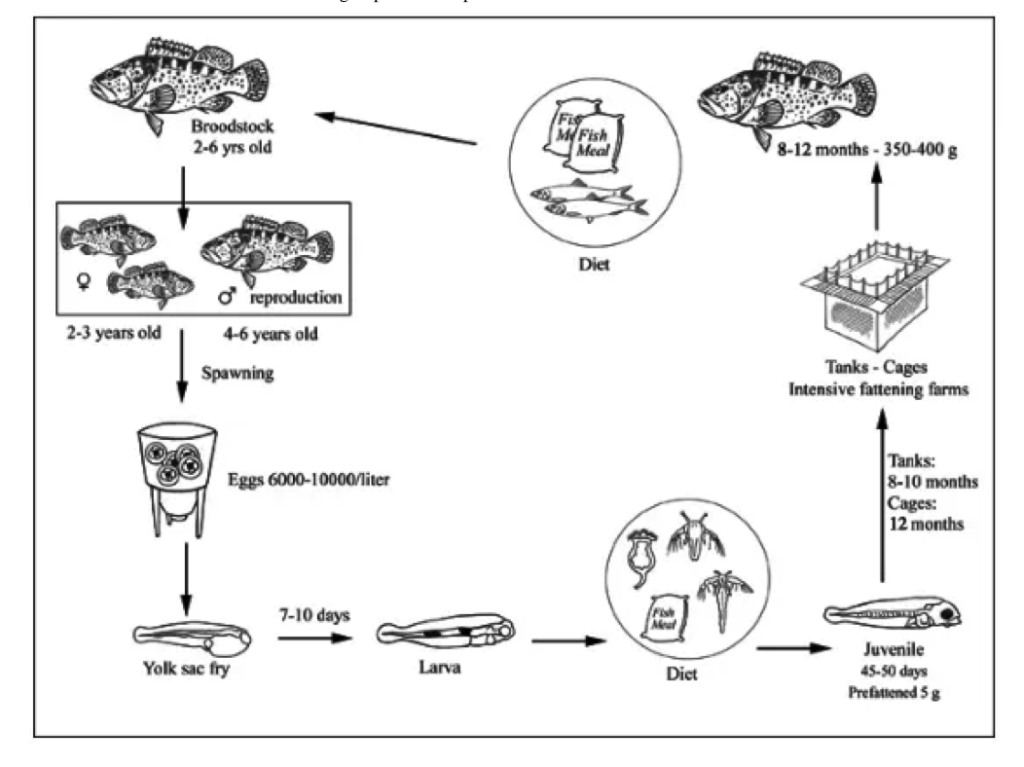
3.2 Product Attributes
- Tailored Growth: Open pen sea cage farming allows for the precise cultivation of fish to reach specific sizes within predetermined timeframes, ensuring consistent product quality.
- Cost Efficiency: This system is renowned for its cost-efficiency, outperforming traditional land-based or enclosed tank methods of aquaculture, providing an economically sustainable approach.
- High Demand Regions: The selected grouper species are in high demand among populations in South East Asia, Hong Kong, Southern China, and North Asia, reflecting the strong market appreciation for these sought-after seafood options.
- Diverse Grouper Varieties: The product range encompasses various grouper varieties, including the Sabah Grouper, which is a hybrid of the Giant and Tiger grouper. Additionally, customers have access to Coral Rock Cod, Marble Grouper, and Camouflage Grouper, offering a wide selection to cater to diverse preferences. Notably, an Australian breeder has achieved success in breeding, spawning, and growing Coral Trout fingerlings to market size, adding further diversity to the product lineup.
3.3 Product Benefits
- Effective Aquaculture Management: Open-pen sea cage fish farming stands out for its efficient aquaculture management practices, which result in reduced disease outbreaks, low mortality rates, and a consistent and stable production output.
- Ideal Marine Environment: The pristine sea surrounding Borneo offers the perfect natural environment for the marine aquaculture industry, contributing to the overall health and quality of the fish being cultivated.
- Superior Protein Production: Fish farming boasts higher efficiency in protein production when compared to other protein sources. The feed conversion ratio for aquaculture production is an impressive 1:1, highlighting its advantage over other protein sources like chicken (2:1), pig (3:1), and beef (7:1).
3.4 Product competitive advantages
- Regional Popularity: Marine aquaculture operations have gained significant popularity in Southeast Asia, and the availability of skilled marine fishery workers is abundant, facilitating smooth operations.
- Market-Driven Species Selection: The ability to select and breed fish species in response to market demand ensures that the product offering remains in alignment with consumer preferences, enhancing market competitiveness.
- Natural Habitat Conditions: The seafront environment provides natural conditions for maintaining water quality, temperature control, and feed availability, mimicking the fish’s natural habitat and contributing to their well-being.
- Expedited Growth and Harvest: Fish can be reared and harvested in a shorter timeframe compared to their growth in the wild, providing an advantage in terms of production efficiency and meeting market demand more promptly.
4.0 Market Overview
4.1 Market Segmentation
The target market primarily consists of three grouper species: Leopard Coral Trout, Sabah Grouper, and Giant Grouper. Geographically, the target markets are Singapore, Hong Kong, China, and North Asia.
4.2 Target Market Strategy
- Strategic Partnerships: Strategic alignment with wholesalers in the target market nations, financial investors, international grouper fish farm operators, and local aquaculture farm owners.
- Quality Assurance Programs (QAP): Commit to delivering top-quality products through rigorous quality control programs.
- Product Variety: Offer a wide range of grouper species to meet the diverse preferences of our customers, we
- Efficient Logistics: Ensure the freshness of the products through swift and reliable delivery services, utilizing a dedicated fleet of transportation.
4.3 Market Demands – 2020 consumption
- Hong Kong: 71 kg/capital
- Korea: 57 kg/capita
- Japan: 45 kg/capita
- China: 41 kg/capita
- Singapore: 22 kg/capita
- Global: 20.5 kg/capita

4.4 Factors Driving Growth
- Global Protein Demand Surge: The increasing worldwide appetite for protein-rich foods is a primary growth driver.
- Depletion of Fish Stocks: Overfishing has led to a decline in fish stocks, creating an urgency for sustainable practices.
- Supplementary Growth Catalysts: Population growth, rising incomes, and growing health-consciousness among consumers are additional factors fuelling industry expansion.
4.5 Key Customers
Target market imports
- China: 250,000 mt
- Hong Kong: 5,000 mt
- Singapore: 5,000 mt
- Japan: 80,000 mt
- Korea: 50,000 mt
China: Key Fish Importers in China
Chang International Group (Ocean Gala)
China National Fisheries Corp
Guang Ding He Shi Shui Chan
Guo Lian Fishery
Qingdao Beiyang Jiamei Seafood
Shanghai Fisheries Group
Sunkfa Group
Zhangzidao Group
Zhejiang Ocean Family
ZS-Shuichu Group
Hong Kong: Live Fish Markets and Seafood Suppliers
Aberdeen Wholesale Fish Market
Chiu Po Kee Seafood
Fat Kee Seafood
FreshGo
Fresh2homehk
Pacific Andes Group
Pakdon Seafood
Tat Kong Group
Wet market

Singapore: Live fish suppliers
Changi Ferry Terminal
Evergreen Seafood
Jurong Wholesale Markets
Lam Kee Fisheries
Pasir Panjang Wholesale Centre
Senoko Wholesale Markets
The Ocean Mart
Japan: Fish Markets and Seafood Suppliers
Adachi Market
Daito Gyorui
Higashimachi Fishing Cooperative
Itochu
Izumisano Fishermans Union Open Market
JFA (Japan Food Artisan)
Maizuru Seafood Market
Marubeni
Maruha Nichiro
Mitsubishi
Nippon Suisan Kaisha
Omi-Cho Market
Osaka’s Central Fish Market
Sumitomo
Tokushima Daisui Uoichi
Toyosu Market
ToyoSuisan Kaisha
Uoichi Co.
Yokohama City Central Wholesale Market
Korea Fish Market and Industry Players
Dongwan Industries
Jagalchi Fish Market
Noryangjin Fish Market
Top Cooperatives (Auctions Halls)
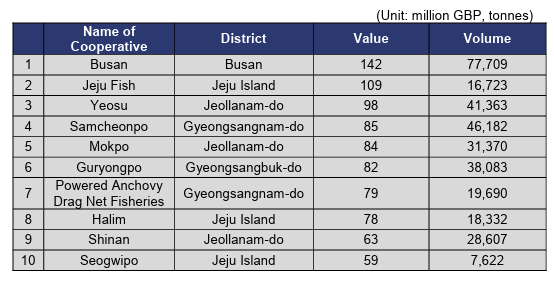
Value Chain of Imported Live Fish in Korea
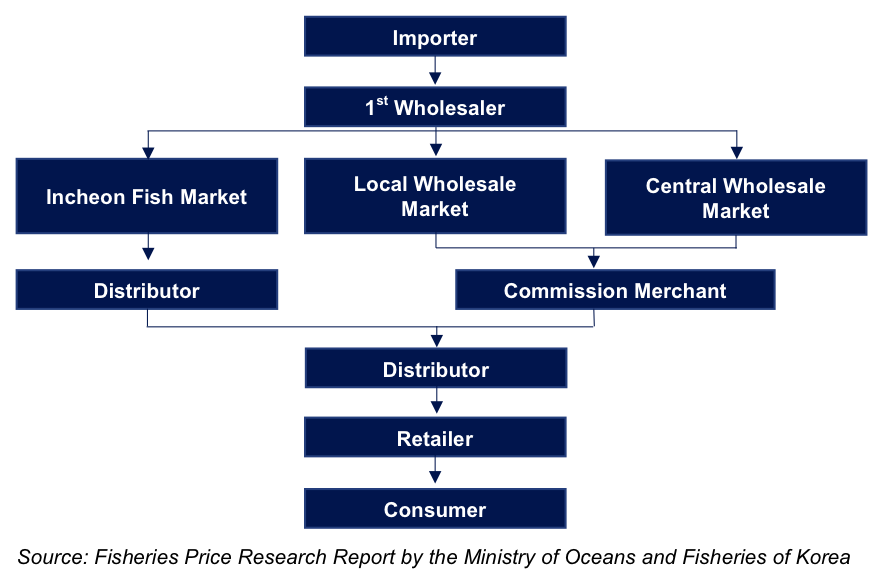
4.6 Competition and Industry
Key Players
Global fish production
- China: 35%
- Asia: 34%
- Americas: 14%
- Europe: 10%
- Africa: 7%
- Oceania: 1%
2018 Exports of fish and fish products:
- China: US$20 billion
- Norway: US$12 billion
- Vietnam: US$7.3 million
- India: US$6.9 billion
Hong Kong: Global Hub for Live Reef Food Fish Trade (LRFFT)
Hong Kong holds a prominent position as the global hub for the Live Reef Food Fish Trade (LRFFT), with the trade estimated to exceed a billion US dollars. However, it is important to note that the actual scale of this trade may be underreported and often operates without robust regulations. This lack of oversight can have adverse consequences on the delicate tropical reef environment.
International Key Players:
Apollo Aquaculture Group
Aquaculture Centre of Excellence
Aquagrow International
Aqua Tech Asia
Australis Aquaculture
Austevoll Seafood
Bac Lieu Fisheries
Bakkafrost P/F
Cermaq
Coastal Enterprises
Cuulong Fish JSC
Dongwon Industries
Encourage Capital
Hatch Blue
Huon Aquaculture
Japfa
Kyokuyo
LSG ASA
Maruha Nichiro
Mowi ASA
National Aquaculture Group
Nippon Suisan Kaisha
Norway Royal Salmon
NZK Salmon
Oberon Securities
Ocean Era
Open Blue Sea Farms
Philosofish
SalMar ASA
Singapore Aquaculture Technologies
Tassal Group
Thai Union Group
The Company One
Vinh Hoan Corp.
Local Key Players:
Aqua Ceria Group
Bahvest Resources
Bayu Aquaculture
Divinity Willing Marine
El Rose Brothers
Fishance
GST Group
Inti Agri Resources
Perum Perindo
Xinghe
Organizational Entities:
Agriculture, Fisheries and Conservation Department of Hong Kong
Department of Fisheries Sabah
Fisheries Research and Development Corporation (FRDC)
Global Seafood Alliance
Hong Kong Chamber of Seafood Merchants Ltd
Hong Kong General Chamber of Fishery & Seafood Industry
Indonesian Fisheries Public Corporation (Perum Perindo)
Japan Fish Traders Association
Japan Fisheries Association
National Federation of Fisheries Cooperatives Korea
National Fishery Products Quality Management Service Korea
Sai Kung Live Fish Association Ltd
Singapore Fish Merchants General Association
Singapore Food Agency
5.0 Operation
5.1 Site Selection Criteria for Coral Trout Sea-Cage Farms
- Seawater Quality: The site should offer optimal seawater quality, including clarity and cleanliness, to ensure the health and growth of coral trout.
- Seawater Temperature: The water temperature should fall within the suitable range for coral trout, promoting their well-being and growth.
- Oxygen Levels: Adequate oxygen levels in the seawater are essential for the survival of coral trout. The site must provide conditions that ensure sufficient oxygen supply.
- Light: Appropriate light levels are essential for the natural behaviour and feeding patterns of coral trout. Sites with access to natural light or suitable artificial lighting are preferred.
- Nutrient Levels: The presence of essential nutrients in the water is vital for the development of marine life, including coral trout. Sites with balanced nutrient levels are favoured.
- Proximity to Workers: The site should be accessible to workers for monitoring and maintenance activities, ensuring the well-being of the fish.
- Logistics Support: Adequate infrastructure and logistical support should be available nearby for transportation, feeding, and other operational requirements.
5.2 Open-sea cage system
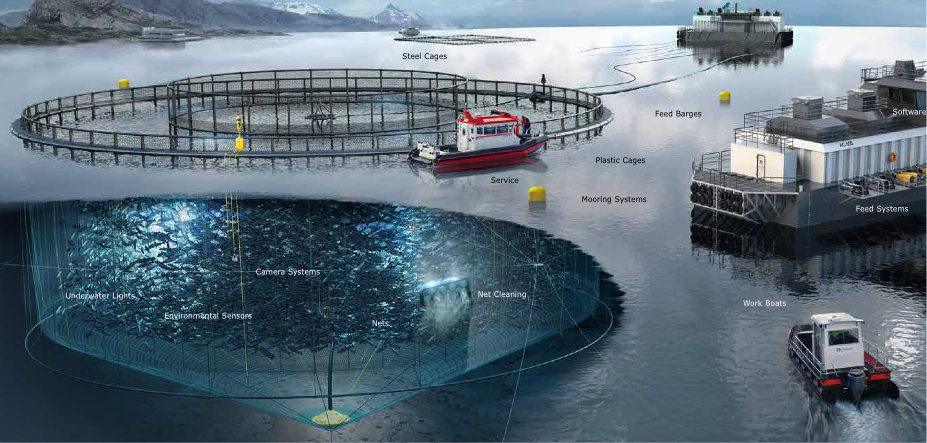
5.3 Physical property: Based on a 20 hectares model

5.4 Fingerlings

5.5 Coral trout fingerlings
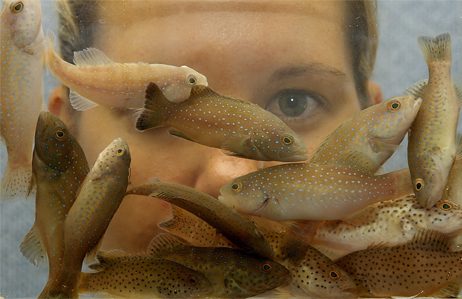
5.7 Production parameters

6.0 Financial Implications
6.1 Investment Strategy
- Export Focus: The primary investment strategy centres on the export market, targeting specific grouper species.
- Scope: Create a comprehensive, vertically integrated marine finfish aquaculture farm. This venture will encompass hatcheries, nurseries, ponds, sheltered sea cages, open ocean sea cages, fish feed mills, packaging facilities, logistics support, transportation networks, sales and marketing efforts, research and development, and associated services.
- Goal: The goal is to invest in a sprawling 5,000-hectare open pen sea cage grouper aquaculture farm. This endeavour aims to produce a substantial annual yield of 400,000 metric tons, generating an impressive income of US$8 billion per year.
- Stage 1: The initial phase involves investing in 2,000 hectares of fish farms, designed to yield 160,000 metric tons of grouper fish annually. These resources will primarily cater to the Singapore and North Asia markets.
- Stage 2: In the subsequent phase, expand the operations further by dedicating an additional 3,000 hectares of fish farms. This expansion will produce an additional 240,000 metric tons of grouper fish annually.
Investment
Capex for a “20 hectares model” sea cage coral trout farm: US$2.52 million
Phase 1: 2,000 hectares = 100 X US$2.52 million = US$252 million
Phase 2: 3,000 hectares = 150 X US$2.52 million = US$378 million
Total investment = US$630 million

Value chain model of the investment segments:
a) wild-caught live reef food fish and b) farmed live reef food fish.
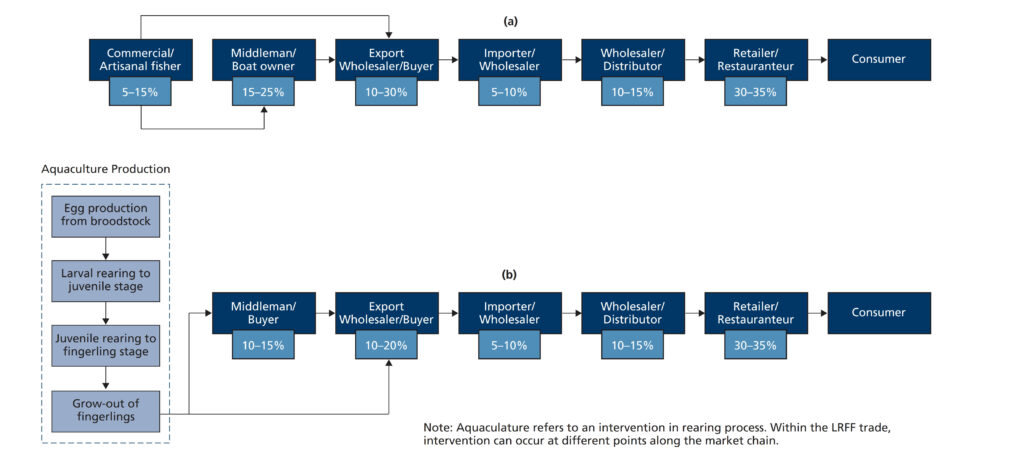
6.2 Production Cost
Production cost: US$5.55/kg or US$5,500/mt
Stage 1: 160,000 mt X US$5,500/mt = US$0.88 billion/year
Stage 2: 240,000 mt X US$5,500/mt = US$1.32 billion/year
Total: US$2.20 billion/year
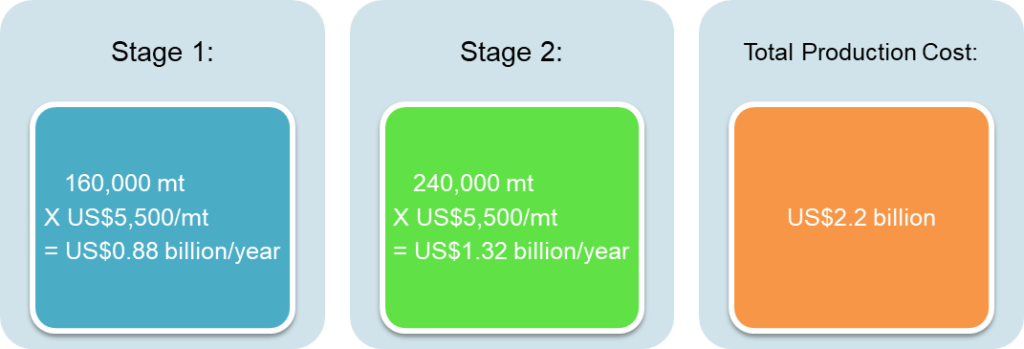
Production cost is $A.

Cost per block hour
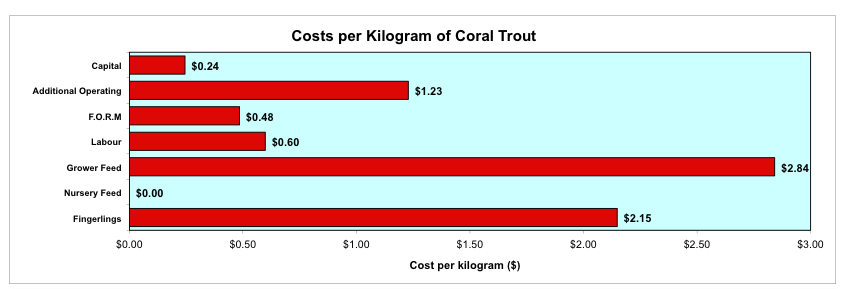
6.3 Prices and Revenues
Revenue:
Phase 1: 160,000 mt X US$20,000/mt = US$3.2 billion/year
Phase 2: 240,000 mt X US$20,000/mt = US$4.8 billion/year
Total: US$8.0 billion/year

Case studies
1. Australia retail prices
- 2018 Coral trout: US$21.33/kg
- 2020 Coral trout: US$25.75/kg
2. Hong Kong retail price
- 2020 Coral trout: US$58.85/kg
6.4 Financial Returns

Case studies
1. Output summary based on the 20 hectares model
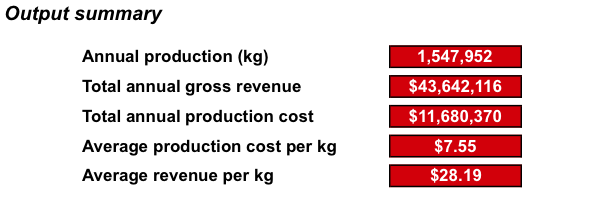
2. Financial return based on the 20 hectares model – 20 years (A$)

3. 2020 New Zealand 2020 study – Open Ocean finfish business case.
- Capex: US$127 million
- Capacity: 10,000 mt of salmon
- Annual operation cost: US$84 million
- Annual revenue: US$122.6 million
- IRR: 12% – 19%
- Payback: 14-17 years
4. 2016 Australia barramundi farm establishment costs
- Capex: US$573,000
- Capacity: 50 mt
- Land area: 15 hectares
- The estimated cost includes land purchase, farm infrastructure and equipment, buildings, pond construction, vehicles, machinery, tanks, pumps and aerators.
5. 2016 Australia Silver perch intensive pond culture startup costs
- Capex: US$735,000
- Capacity: 50 – 80 mt
- Land area: 10 hectares
6. 2019 Malaysia Xinghe holdings bought Vannamei prawn farm.
- Investment: US$24 million
- Capacity: 2,000 mt including 102 cultivation ponds
- Land area: 40 hectares
2019 Financial Income of of listed aquaculture companies
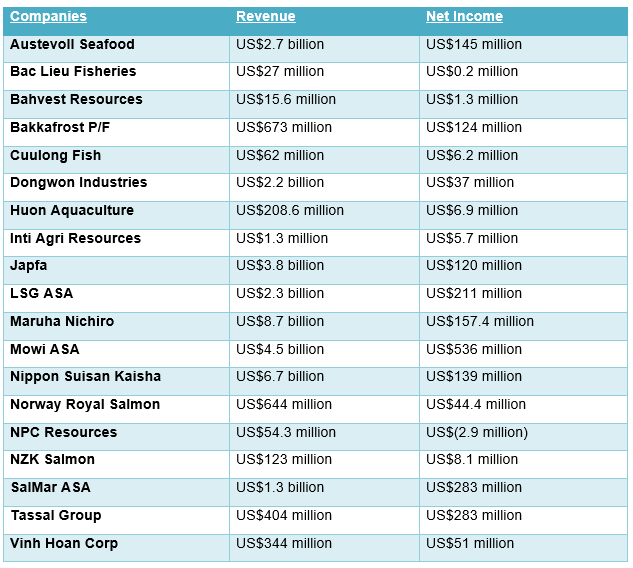
6.5 Source of Funding
1. Strategic investors
- New Investor: A project leader with a strong focus on business and financial management, bringing expertise and resources to the venture.
- Financier: Aquaculture private equity groups and financial institutions specializing in aquaculture investments.
- Aquaculture Operator: Collaboration with international aquaculture experts and established grouper fish farm operators, leveraging their industry know-how.
- Target Market: Seeking investments from China, Hong Kong, Singapore, Japan, and Korea’s live fish importers, who have a vested interest in the success of our project.
2. Private equities and Investors
8F Aquaculture ADM Capital Argo Investments Alfred Berg Kapitalforvaltning Alimentos Ventures Amerra Capital Management Ankur Capital Antin Infrastructure Partners Aqua-Spark Arcadia SGR Arctic Fund Management Argentum Asset Management One Australian Aquaculture Investment Fund Aviva Investors Beach Point Capital BlackRock Blue Oceans Capital Bluefront Equity Bonafide Wealth Management Bregal Partners Broodstock Capital Butterfly Equity Cadman Capital Group Caisse de dépôt et placement du Québec CANDRIAM Comgest CTBC Investments Daiwa Asset Management Danske Invest Asset Management Degroof Petercam Asset Management Dimensional Fund Advisors Diorasis International DNB Asset Management Dragon Capital Management Encourage Capital Ferd Capital FIL Investment Management Folketrygdfondet Global Alpha Capital Management GMO Investment Handelsbanken Asset Management Hatch Blue Havbruksinves Hellesund Fiskeoppdrett Henderson Global Investors Impax Asset Management JPMorgan Asset Management Katapult Ocean KB Asset Management Kverva Kvika Longship AS Mawer Investment Management Mirova Natural Capital Mitsubishi UFJ Kokusai Asset Management Neptune NRCP Nikko Asset Management NN Investment Partners Nomura Asset Management Nordea Investment Management Northstar Group Ocean 14 Capital Oddo BHF Asset Management Pacific 6 PAI Partners Pareto Asset Management Peritus Capital Philosofish Portobello Capital S2G Ventures Sokotra Capital SSgA Funds Management Stafford Capital Partners Storebrand Asset Management Südlich Capital Sumitomo Mitsui Trust Asset Management Summa Equity Swedbank Robur Fonder Vanguard Group Varenne Capital Partners Wilson Asset Management Yarra Funds Management
3. Consultants, development and funding managers in the Aquaculture Industries:
Aquaculture Stewardship Council AquaSol Boston Consulting Group (BCG) CREO Deloitte Ernst & Young (EY) FAIRR Global Aquaculture Alliance Institute of Aquaculture KPMG Leroy Seafood McKinsey & Company Morenot Ocean Stewards Institute PricewaterhouseCoopers (PwC) World Aquaculture Society
6.6 Pursuing Aquaculture’s Legacy
Over 2,500 years ago in China, a visionary billionaire named Fan Li blazed a trail in the world of large-scale aquaculture. His groundbreaking work included penning a book that detailed the intricacies of aquaculture farming. This comprehensive guide covered fishpond design, fingerling specifications, the ideal male-to-female fish ratio for breeding, growth timelines, release schedules, harvest cycles, and the anticipated economic returns. When asked about the secret behind his wealth and success, Fan Li famously replied, “There are five ways to make money, and aquaculture ranks first.” Remarkably, his legacy extends beyond aquaculture, as he was also known as the husband of Xi Shi, one of the four most famous beauties in Chinese history.
Fast forward to the present day, and the aquaculture landscape continues to evolve. Grouper stands as a high-value asset in the aquaculture business, offering substantial returns. To tap into its full potential, the key lies in investing in downstream segments. This encompasses areas such as hybrid varieties, specialized feed formulations, and production integration that not only meets the discerning palates of consumers but also delivers essential nutrients in a cost-effective manner.
The real financial opportunity lies in propelling grouper aquaculture into the forefront of protein production. As a top-dollar earner, grouper has the potential to become a dominant player in the aquaculture industry, contributing significantly to both economic prosperity and sustainable food production.
7.0 Management Team
7.1 Key Management Team
- Mentor:
Mentors are visionary pioneers and industry leaders with a vast global network. They provide invaluable guidance and inspiration.
- Coaches:
Coaches are mission-oriented industry experts who offer practical solutions to challenges, ensuring the team stays focused on its objectives.
- Partners:
1. An aquaculture project leader with strategic vision and motivation to transform the source of protein source for the world.
2. A reputable financier with access to aquaculture funding
3. A team of experienced international aquaculture operators.
4. Target market groups in North Asia.
In the aquaculture industry, several global leaders have made significant contributions, shaping its growth and success. Here is a list of some of these remarkable individuals, honoured for their vision and dedication:
- Brian O’Hanlon
- Dr Carole Engle
- Gibran Huzaifah
- Bill Johnston
- Professor Khoo
- Dr Geoffrey Muldoon
- Dr Michael Rimmer
- Professor Yvonne Sadovy
- Neil Anthony Sims
These are just a few of the outstanding professionals and captains of the industry. The readers are encouraged to explore further and conduct their research to learn more about the management teams in this dynamic field.
7.2 Key Management Team Model
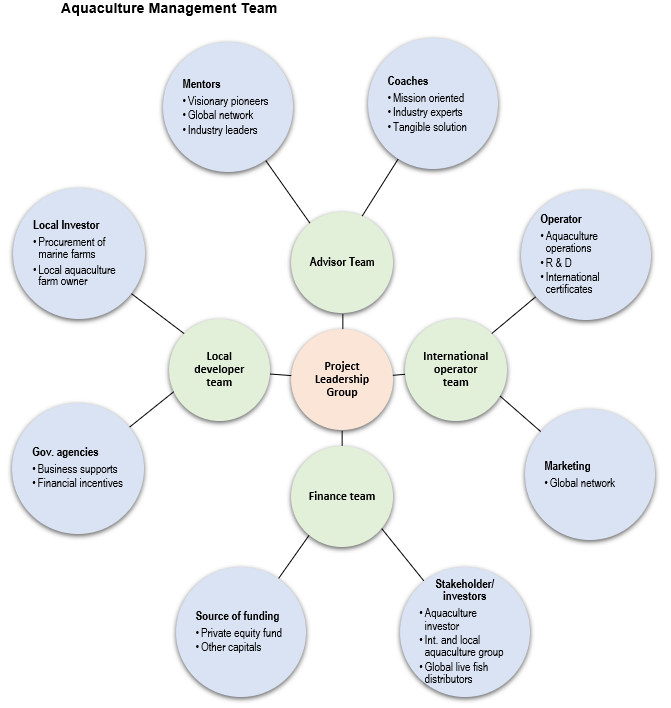
8.0 Unique Business Model
8.1 Successful Track Record
- Advanced Aquaculture Expertise: Proficiency in advanced aquaculture technology and production methods, ensuring efficient and sustainable operations.
- Access to Aquaculture Financing: Established relationships with international financiers specializing in aquaculture funds, facilitating secure funding channels.
- Global Marketing and Sales Network: Extensive global networks within the live fish trade market, encompassing marketing and sales channels to reach diverse audiences.
- Government Support: Leveraging comparative advantages through strong support from local government fishery agencies, fostering a conducive environment.
8.2 Entry Model
- Strategic Alliances: Forming strategic alliances with key stakeholders to create a fully integrated model spanning from hatchery to sales. This includes partnering with existing grouper aquaculture farm operators, securing commitments from target market groups comprising live fish distributors and end buyers, and establishing a dedicated aquaculture private equity fund.
- Acquisition and Expansion: Establishing a new entity for the acquisition of existing aquaculture farms, followed by a strategic expansion of operations and production.
8.3 Distinctive Advantages
- Market Demand Insight: The ability to discern and fulfill both quantity and quality demands in the end market, ensuring consumer satisfaction.
- International Partnerships: Partnerships with top international aquaculture farm operators, enriching expertise and global reach.
- Financial Security: Securing requisite financial backing to support our ventures and ensure stability and growth.
- Strategic Location: Geographical proximity to the Asia Pacific markets positions the team favourably for future expansion, aligning with the burgeoning regional demand.
9.0 Key Success Factors & Risk Mitigation
9.1 Key Success Factors
- Broodstock Selection and Fry Production: Ensuring the careful selection of broodstock and efficient fry production processes to maintain high-quality fish stocks.
- Disease and Parasite Prevention: Implementing active measures for disease and parasite prevention, including a quarantine distance of 15 km to contain and control potential outbreaks.
- Nutrition Programs: Developing comprehensive and effective nutrition programs to support the health and growth of the fish.
- Quality Control on Food Safety: Implementing rigorous quality control programs for food safety and adhering to strict food traceability policies and procedures.
- Optimal Sea Area Utilization: Maximizing the efficient use of sea areas for marine aquaculture fish farms to optimize production.
9.2 Risks
- Disease and Parasite Spread: The rapid spread of diseases and sea lice in high-density fish environments.
- Environmental Impact: Potential environmental concerns related to waste disposal, discharge, and fish feed.
- Fish Escape: Escaped farmed fish during storms or typhoons, leading to income loss and potential invasiveness.
- Price Fluctuations: Global price fluctuations in the aquaculture market.
9.3 Risk Mitigation
- Quarantine and Separate Facilities: Implementing a 15 km quarantine distance and maintaining separate production facilities for various stages to control the spread of disease and parasites. Utilizing open ocean systems to flush farms of waste and pests.
- Advanced Production and Technology: Employing advanced production methods and new technologies to minimize waste and discharge. Utilizing deeper water depths to reduce pollution of sea floors. Emphasizing feed efficiency as a key factor.
- Site Selection and Design: Carefully selecting aquaculture sites in areas without typhoons to prevent environmental impact. Employing secure netting and design to reduce the risk of fish escapes.
- Market Contracts: Establishing a robust sales and distribution network to provide pricing stability through contractual agreements.
- Breed and Broodstock Selection: Focusing on the selection of high-quality breeds and broodstock to improve seed production rates.
- Quality Feed: Ensuring the selection of top-quality feed for healthy and safe food production.
- Processing Facilities: Maintaining clean and efficient processing facilities to uphold product quality.
- Insurance Coverage: Securing comprehensive insurance coverage to enhance the bankability and financial security of the fish farm operation.
10.0 Exit Strategy
10.1 Forms of Exit
- IPO (Initial Public Offer): An IPO is a common way to exit, allowing investors to sell their shares to the public when the company goes public.
- M & A (Merger and Acquisition): The company may be acquired by another company in a similar industry as a strategic acquisition.
- Sale: Private investors have the option to sell their stakes to another private equity firm.
- Buyback: Management of the company can choose to buy back the equity stake from private investors.
10.2 Benefits to New Investors
- Market: New investors gain access to target markets comprising live fish traders and distributors in North Asia, with the opportunity to expand into other Asian nations.
- Revenue: The business offers recurring revenue streams with future expansion potential.
- Price Stability: Stable income derived from aquaculture competes favourably with other protein sources, reducing price fluctuation risks.
- Product Diversity: Introduction of new hybrid products provides a wider range of choices to cater to consumer preferences.
- Opportunity: New investors can capitalize on downstream product development and income opportunities.
- Exit Timing: The exit is anticipated after the payback period, ensuring profitability.
10.3 Attraction to New Investors
- Market Share: Acquiring the business allows new investors to capture additional market share in North Asia.
- Cost Efficiency: An acquisition presents the opportunity to optimize costs and operational efficiency.
- Ebitda Enhancement: New owners can leverage fresh ideas to enhance EBITDA (Earnings Before Interest, Taxes, Depreciation, and Amortization) and overall profitability.
- Leadership Improvement: The introduction of a new leadership team can enhance business and operational performance.
- Distribution Expansion: Access to new markets, products, and distribution channels creates growth potential.
- Increased Revenue Streams: Diversification into additional product lines leads to enhanced revenue streams.
10.4 Winning Strategy
- Team Power: A formidable team comprising top global players ensures high-quality management practices and profitable operations.
- Win-Win: Investment in providing affordable protein sources proves to be a profitable endeavour while establishing benchmark standards and leading the Live Reef Fish Fishery (LRFF) aquaculture industry.
- Sustainability Focus: The venture not only secures profits but also contributes to coral reef protection and the reduction of unsustainable reef fishing practices, aligning with environmental and ethical goals.
